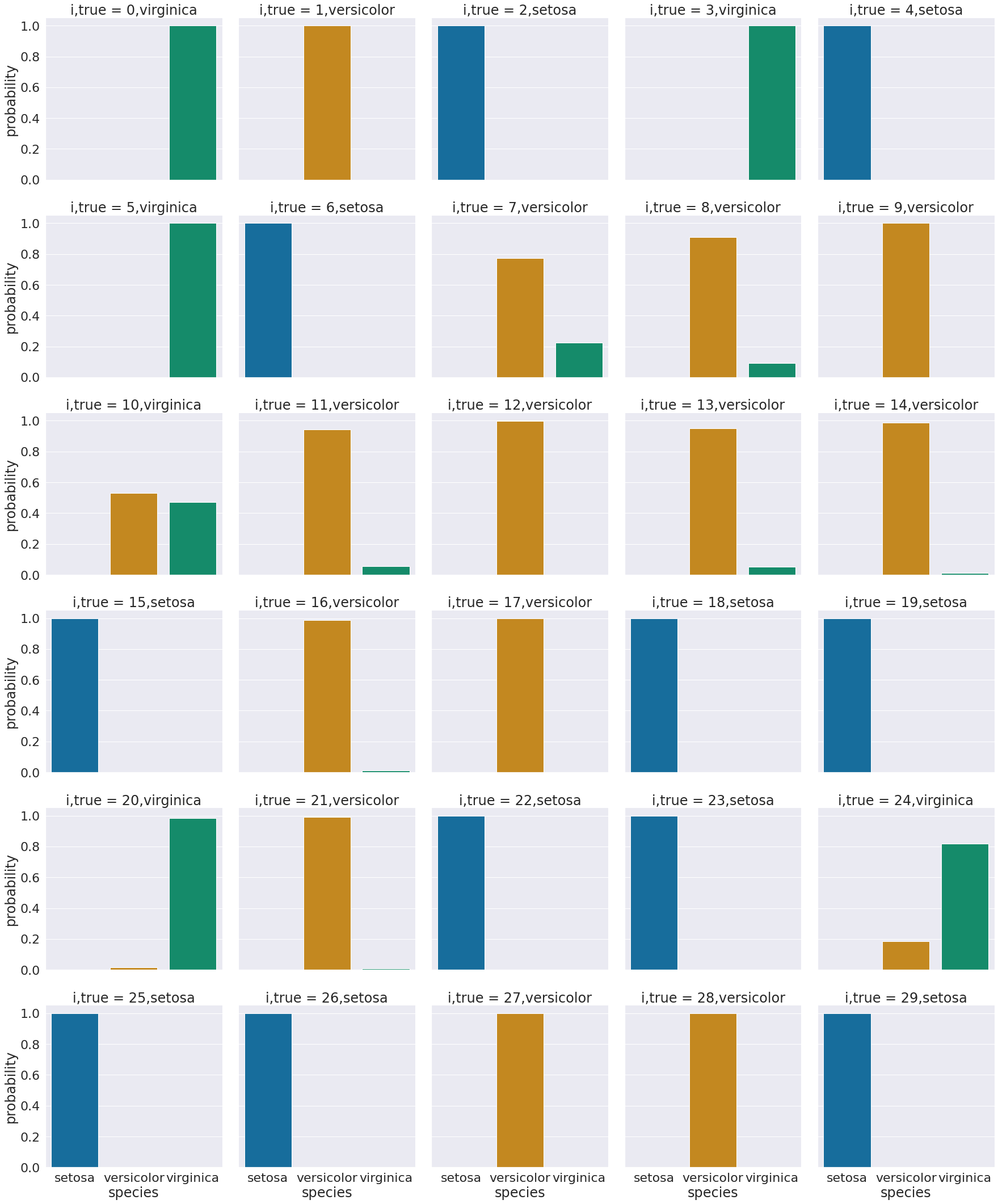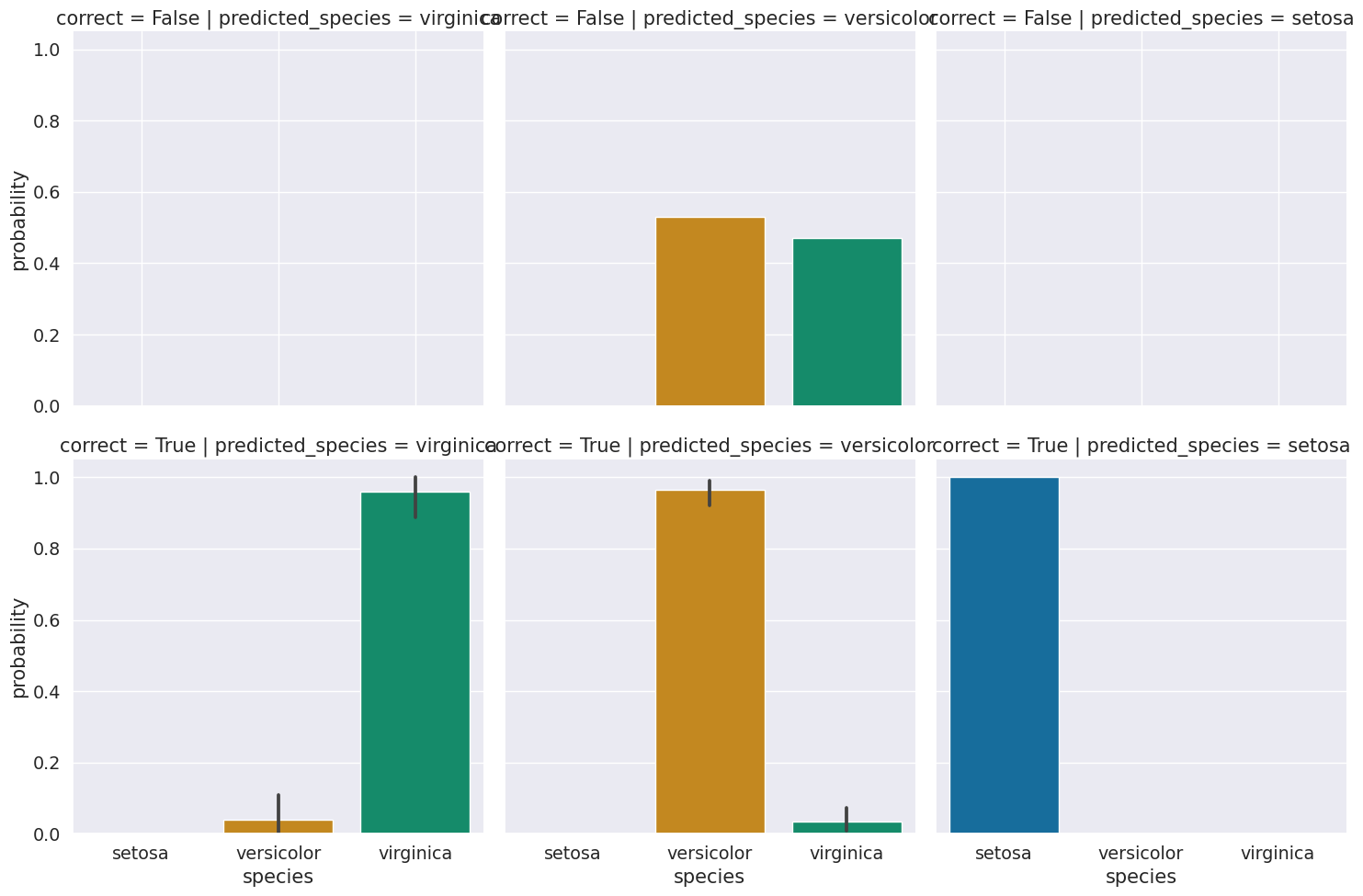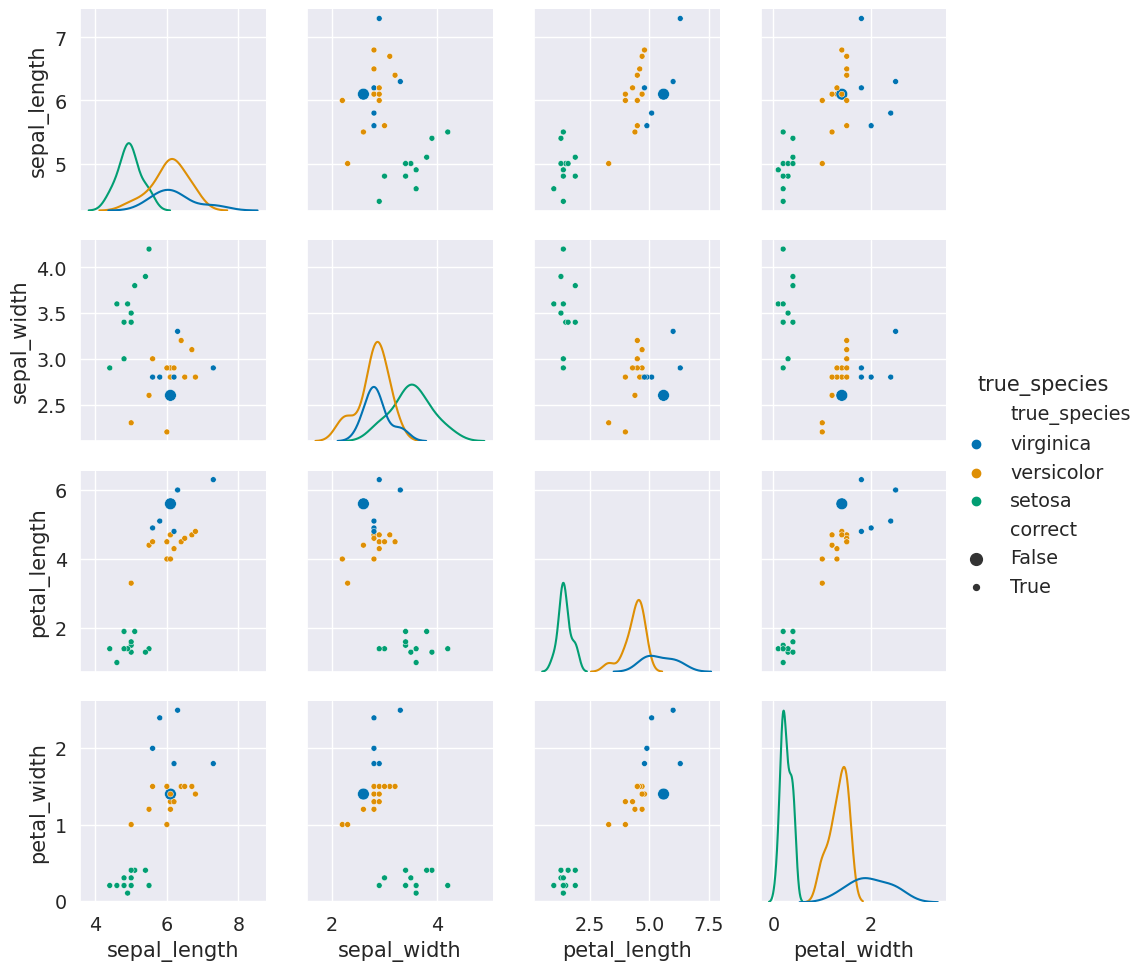Making Predictions in Generative Model
17. Making Predictions in Generative Model#
import pandas as pd
import seaborn as sns
import numpy as np
from sklearn.model_selection import train_test_split
from sklearn.naive_bayes import GaussianNB
from sklearn.metrics import confusion_matrix, classification_report, roc_auc_score
iris_df = sns.load_dataset('iris')
We’ll load the data again
iris_df.head(1)
| sepal_length | sepal_width | petal_length | petal_width | species | |
|---|---|---|---|---|---|
| 0 | 5.1 | 3.5 | 1.4 | 0.2 | setosa |
Next we indicate the feature variables and target and split into test and train sets. Well use 80% of the data for training.
feature_vars = ['sepal_length', 'sepal_width','petal_length', 'petal_width',]
target_var = 'species'
X_train, X_test, y_train, y_test = train_test_split(iris_df[feature_vars],
iris_df[target_var], train_size=.8, random_state=0)
We can confirm the shape is as expected
X_train.shape
(120, 4)
iris_df.shape
(150, 5)
.8*150
120.0
Next we again initialize and fit the classifier
gnb = GaussianNB()
gnb.fit(X_train, y_train)
GaussianNB()In a Jupyter environment, please rerun this cell to show the HTML representation or trust the notebook.
On GitHub, the HTML representation is unable to render, please try loading this page with nbviewer.org.
GaussianNB()
We can compute predictions
y_pred = gnb.predict(X_test)
y_pred
array(['virginica', 'versicolor', 'setosa', 'virginica', 'setosa',
'virginica', 'setosa', 'versicolor', 'versicolor', 'versicolor',
'versicolor', 'versicolor', 'versicolor', 'versicolor',
'versicolor', 'setosa', 'versicolor', 'versicolor', 'setosa',
'setosa', 'virginica', 'versicolor', 'setosa', 'setosa',
'virginica', 'setosa', 'setosa', 'versicolor', 'versicolor',
'setosa'], dtype='<U10')
And score the results
gnb.score(X_test,y_test)
0.9666666666666667
We saw last week that when we fit the Gaussian Naive Bayes, it computes a mean
\(\theta\) and variance \(\sigma\) and adds them to model parameters in attributes
gnb.theta_, gnb.sigma_.
When we use the predict method, it uses those parameters to calculate the likelihood of the sample according to a Gaussian distribution (normal) for each class and then calculates the probability of the sample belonging to each class.
gnb.predict_proba(X_test)
array([[1.63380783e-232, 2.18878438e-006, 9.99997811e-001],
[1.82640391e-082, 9.99998304e-001, 1.69618390e-006],
[1.00000000e+000, 7.10250510e-019, 3.65449801e-028],
[1.58508262e-305, 1.04649020e-006, 9.99998954e-001],
[1.00000000e+000, 8.59168655e-017, 4.22159374e-027],
[6.39815011e-321, 1.56450314e-010, 1.00000000e+000],
[1.00000000e+000, 1.09797313e-016, 5.30276557e-027],
[1.25122812e-146, 7.74052109e-001, 2.25947891e-001],
[5.34357526e-150, 9.07564955e-001, 9.24350453e-002],
[5.67261712e-093, 9.99882109e-001, 1.17891111e-004],
[2.38651144e-210, 5.29609631e-001, 4.70390369e-001],
[8.12047631e-132, 9.43762575e-001, 5.62374248e-002],
[5.25177109e-132, 9.98864361e-001, 1.13563851e-003],
[1.24498038e-139, 9.49838641e-001, 5.01613586e-002],
[4.08232760e-140, 9.88043864e-001, 1.19561365e-002],
[1.00000000e+000, 7.12837229e-019, 4.10162749e-029],
[4.19553996e-131, 9.87944980e-001, 1.20550201e-002],
[4.13286716e-111, 9.99942383e-001, 5.76167389e-005],
[1.00000000e+000, 2.24933112e-015, 3.63624519e-026],
[1.00000000e+000, 9.86750131e-016, 2.42355087e-025],
[1.85930865e-186, 1.66966805e-002, 9.83303319e-001],
[8.83060167e-130, 9.92757232e-001, 7.24276827e-003],
[1.00000000e+000, 4.26380344e-013, 4.34222344e-023],
[1.00000000e+000, 1.28045851e-016, 1.26708019e-027],
[2.43739221e-168, 1.83516225e-001, 8.16483775e-001],
[1.00000000e+000, 2.62431469e-018, 6.72573168e-029],
[1.00000000e+000, 3.20605389e-011, 1.52433420e-020],
[2.20964201e-110, 9.99291229e-001, 7.08771072e-004],
[1.39297338e-046, 9.99999972e-001, 2.81392389e-008],
[1.00000000e+000, 1.85943966e-013, 1.58833385e-023]])
These are hard to interpret as is, one option is to plot them
# make the prbabilities into a dataframe labeled with classes & make the index a separate column
prob_df = pd.DataFrame(data = gnb.predict_proba(X_test), columns = gnb.classes_ ).reset_index()
# add the predictions
prob_df['predicted_species'] = y_pred
prob_df['true_species'] = y_test.values
# for plotting, make a column that combines the index & prediction
pred_text = lambda r: str( r['index']) + ',' + r['predicted_species']
prob_df['i,pred'] = prob_df.apply(pred_text,axis=1)
# same for ground truth
true_text = lambda r: str( r['index']) + ',' + r['true_species']
prob_df['correct'] = prob_df['predicted_species'] == prob_df['true_species']
# a dd a column for which are correct
prob_df['i,true'] = prob_df.apply(true_text,axis=1)
prob_df_melted = prob_df.melt(id_vars =[ 'index', 'predicted_species','true_species','i,pred','i,true','correct'],value_vars = gnb.classes_,
var_name = target_var, value_name = 'probability')
prob_df_melted.head()
| index | predicted_species | true_species | i,pred | i,true | correct | species | probability | |
|---|---|---|---|---|---|---|---|---|
| 0 | 0 | virginica | virginica | 0,virginica | 0,virginica | True | setosa | 1.633808e-232 |
| 1 | 1 | versicolor | versicolor | 1,versicolor | 1,versicolor | True | setosa | 1.826404e-82 |
| 2 | 2 | setosa | setosa | 2,setosa | 2,setosa | True | setosa | 1.000000e+00 |
| 3 | 3 | virginica | virginica | 3,virginica | 3,virginica | True | setosa | 1.585083e-305 |
| 4 | 4 | setosa | setosa | 4,setosa | 4,setosa | True | setosa | 1.000000e+00 |
Now we have a data frame where each rown is one the probability of one sample belonging to one class. So there’s a total of number_of_samples*number_of_classes rows
prob_df_melted.shape
(90, 8)
len(y_pred)*len(gnb.classes_)
90
One way to look at these is to, for each sample in the test set, make a bar chart of the probability it belongs to each class. We added to the data frame information so that we can plot this with the true class in the title using col = 'i,true'
sns.set_theme(font_scale=2, palette= "colorblind")
# plot a bar graph for each point labeled with the prediction
sns.catplot(data =prob_df_melted, x = 'species', y='probability' ,col ='i,true',
col_wrap=5,kind='bar')
<seaborn.axisgrid.FacetGrid at 0x7fd4af264ca0>

We see that most sampples have nearly all of their probability mass (all probabiilties in a distribution sum (or integrate if continuous) to 1, but a few samples are not.
Try it yourself
Try adding a column that could change the headings to include an indicator of which are correct or not)
For now, we’ll group and look at on average, what the distributions are for correct vs incorrect based on predictions.
sns.set(font_scale=1.25, palette= "colorblind")
sns.catplot(data =prob_df_melted, x = 'species', y='probability' ,
col ='predicted_species',row ='correct', kind='bar')
<seaborn.axisgrid.FacetGrid at 0x7fd4c038e9d0>

We see that the errors were all for versicolor, and on average the distribution is very uncertain for those samples. Those samples are probably hard to distinguish. We could check by creating a data frame with the data and the information about predictions and correct values.
prob_data_df = pd.concat([prob_df,X_test.reset_index()],axis=1).drop(columns=['index'])
prob_data_df.head(2)
| setosa | versicolor | virginica | predicted_species | true_species | i,pred | correct | i,true | sepal_length | sepal_width | petal_length | petal_width | |
|---|---|---|---|---|---|---|---|---|---|---|---|---|
| 0 | 1.633808e-232 | 0.000002 | 0.999998 | virginica | virginica | 0,virginica | True | 0,virginica | 5.8 | 2.8 | 5.1 | 2.4 |
| 1 | 1.826404e-82 | 0.999998 | 0.000002 | versicolor | versicolor | 1,versicolor | True | 1,versicolor | 6.0 | 2.2 | 4.0 | 1.0 |
feature_vars
['sepal_length', 'sepal_width', 'petal_length', 'petal_width']
g = sns.PairGrid(prob_data_df,x_vars=feature_vars,y_vars= feature_vars,hue='true_species')
g.map_diag(sns.kdeplot)
g.map_offdiag(sns.scatterplot, size=prob_data_df["correct"])
g.add_legend()
<seaborn.axisgrid.PairGrid at 0x7fd4ae680820>

Here we see that the large dots (the incorrect ones) are all nearby to points of a different color. They were in fact samples that are similar to the other species. So again, this result makes sense and helps us see when classifiers that are a good fit for the data will still make mistakes.
We can also look at the probabilites of the predicted sample using max
p_predicted = np.max(gnb.predict_proba(X_test),axis=1)
p_predicted
array([0.99999781, 0.9999983 , 1. , 0.99999895, 1. ,
1. , 1. , 0.77405211, 0.90756495, 0.99988211,
0.52960963, 0.94376258, 0.99886436, 0.94983864, 0.98804386,
1. , 0.98794498, 0.99994238, 1. , 1. ,
0.98330332, 0.99275723, 1. , 1. , 0.81648378,
1. , 1. , 0.99929123, 0.99999997, 1. ])
We see here that most of the predictions are pretty confident.
We can also use the probabilities to then compute predictions and compare these to what the predict method gave, to confirm that this is how the predict method works.
pd.DataFrame(data = gnb.predict_proba(X_test), columns = gnb.classes_ ).idxmax(axis=1) ==y_pred
0 True
1 True
2 True
3 True
4 True
5 True
6 True
7 True
8 True
9 True
10 True
11 True
12 True
13 True
14 True
15 True
16 True
17 True
18 True
19 True
20 True
21 True
22 True
23 True
24 True
25 True
26 True
27 True
28 True
29 True
dtype: bool

